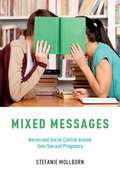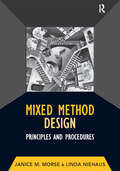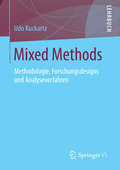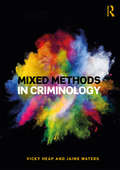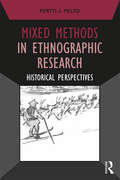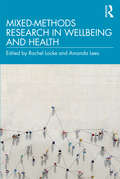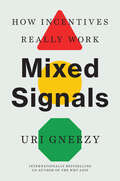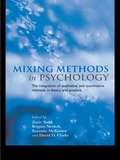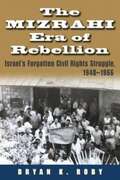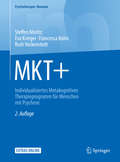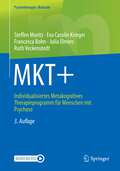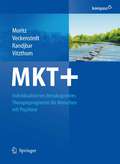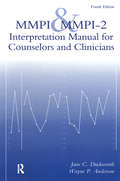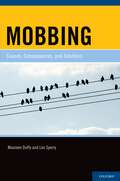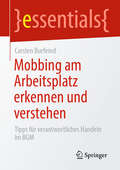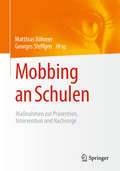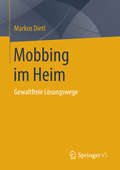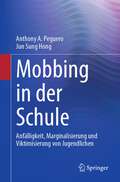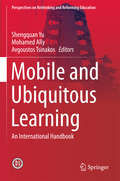- Table View
- List View
Mixed Messages: Norms and Social Control around Teen Sex and Pregnancy
by Stefanie MollbornSex is bad. Unprotected sex is a problem. Having a baby would be a disaster. Abortion is a sin. Teenagers in the United States hear conflicting messages about sex from everyone around them. How do teens understand these messages? In Mixed Messages, Stefanie Mollborn examines how social norms and social control work through in-depth interviews with college students and teen mothers and fathers, revealing the tough conversations teeangers just can't have with adults. Delving into teenagers' complicated social worlds Mollborn argues that by creating informal social sanctions like gossip and exclusion and formal communication such as sex education, families, peers, schools, and communities strategize to gain control over teens' behaviors. However, while teens strategize to keep control, they resist the constraints of the norms, revealing the variety of outcomes that occur beyond compliance or deviance. By showing that the norms existing today around teen sex are ineffective, failing to regulate sexual behavior, and instead punishing teens that violate them, Mollborn calls for a more thoughtful and consistent dialogue between teens and adults, emphasizing messages that will lead to more positive health outcomes.
MIXED MESSAGES C: Norms and Social Control around Teen Sex and Pregnancy
by Stefanie MollbornSex is bad. Unprotected sex is a problem. Having a baby would be a disaster. Abortion is a sin. Teenagers in the United States hear conflicting messages about sex from everyone around them. How do teens understand these messages? In Mixed Messages, Stefanie Mollborn examines how social norms and social control work through in-depth interviews with college students and teen mothers and fathers, revealing the tough conversations teeangers just can't have with adults. Delving into teenagers' complicated social worlds Mollborn argues that by creating informal social sanctions like gossip and exclusion and formal communication such as sex education, families, peers, schools, and communities strategize to gain control over teens' behaviors. However, while teens strategize to keep control, they resist the constraints of the norms, revealing the variety of outcomes that occur beyond compliance or deviance. By showing that the norms existing today around teen sex are ineffective, failing to regulate sexual behavior, and instead punishing teens that violate them, Mollborn calls for a more thoughtful and consistent dialogue between teens and adults, emphasizing messages that will lead to more positive health outcomes.
Mixed Method Design: Principles and Procedures (ISSN)
by Janice M MorseThe use of mixed methods designs for conducting research has become a major trend in social science research. Renowned methodological experts Janice Morse and Linda Niehaus present a guide to intermediate and experienced researchers on the possibilities inherent in mixed method research. They offer the basic principles of conducting this kind of study, then examine a wide variety of design options available to the researcher, including their strengths and weaknesses and when to use them. Providing examples from a variety of disciplines, examining potential threats to validity, and showing the relationship between method and theory, the book will be a valuable addition to the methodologist’s library and a useful text in courses in research design.
Mixed Method Design: Principles and Procedures (ISSN #4)
by Janice M MorseThe use of mixed methods designs for conducting research has become a major trend in social science research. Renowned methodological experts Janice Morse and Linda Niehaus present a guide to intermediate and experienced researchers on the possibilities inherent in mixed method research. They offer the basic principles of conducting this kind of study, then examine a wide variety of design options available to the researcher, including their strengths and weaknesses and when to use them. Providing examples from a variety of disciplines, examining potential threats to validity, and showing the relationship between method and theory, the book will be a valuable addition to the methodologist’s library and a useful text in courses in research design.
Mixed Methods: Methodologie, Forschungsdesigns und Analyseverfahren
by Udo KuckartzMixed Methods-Ansätze gelten mittlerweile im angelsächsischen Raum als „drittes methodologisches Paradigma“ jenseits der Dualität von qualitativ versus quantitativ. Dieses Buch macht Forscher aus den Sozial- und Erziehungswissenschaften mit diesem neuen Methodenverständnis vertraut und gibt eine praktische Einführung in Designformen und Analysemethoden.
Mixed Methods in Criminology
by Vicky Heap Jaime WatersMixed Methods in Criminology is the first book to bring together the discipline of criminology with the mixed methods research strategy, which has become increasingly prominent within criminological teaching and research. The book is structured so that it charts the course of a criminological mixed methods study. Starting with an introduction to mixed methods and its implications for criminology and criminological research, the book then works systematically through the planning stages of a research project. Developing research questions, aims and objectives is discussed alongside literature searching skills and the project planning process, before the principles and practice of ethical research are summarised. Next come chapters on philosophy, mixed methods design, combining the data, research design and sampling, data collection methods and data analysis; delivering a comprehensive overview of how to undertake a mixed methods research project in practice. This is followed by a chapter on troubleshooting, which provides useful advice from experienced mixed methods researchers, before a detailed account of how to write-up mixed methods research is presented. The book concludes with a range of real-life mixed methods case studies to demonstrate how the techniques outlined in this book have been employed in reality and to inspire new criminological mixed methods projects. Providing straightforward, easy to follow guidance, Mixed Methods in Criminology is the essential student companion for any criminological mixed methods research project. Drawing on the authors' years of experience teaching research methods, the book is written in a supportive and encouraging tone that will serve as a reference and guide for those embarking on their adventures 'in the field'.
Mixed Methods in Ethnographic Research: Historical Perspectives (Developing Qualitative Inquiry)
by Pertti J. PeltoMixed Methods in Ethnographic Research: Historical Perspectives captures the dynamic history and development of mixed methods research in a narrative of personal discovery, growth, and experience. Distinguished ethnographer and methodologist Pertti Pelto, who first called for the integration of qualitative and quantitative research methods nearly half a century ago, establishes a direct line between the earliest examples of ethnographic research and the ongoing mixed method discussions in academic institutions throughout the world. By bringing together such distinct historical perspectives with his own reflections on mixed methods research, Pelto offers a rare and endlessly enriching account that will satisfy the ever-growing need for a better quality of practical data gathering and give researchers a foundation for promoting mixed methods in the future.
Mixed Methods in Ethnographic Research: Historical Perspectives (Developing Qualitative Inquiry)
by Pertti J. PeltoMixed Methods in Ethnographic Research: Historical Perspectives captures the dynamic history and development of mixed methods research in a narrative of personal discovery, growth, and experience. Distinguished ethnographer and methodologist Pertti Pelto, who first called for the integration of qualitative and quantitative research methods nearly half a century ago, establishes a direct line between the earliest examples of ethnographic research and the ongoing mixed method discussions in academic institutions throughout the world. By bringing together such distinct historical perspectives with his own reflections on mixed methods research, Pelto offers a rare and endlessly enriching account that will satisfy the ever-growing need for a better quality of practical data gathering and give researchers a foundation for promoting mixed methods in the future.
Mixed-Methods Research in Wellbeing and Health
by Rachel Locke Amanda LeesMixed-Methods Research in Wellbeing and Health brings together nine examples of high-quality research into wellbeing and health using a range of mixed methods. Research that employs mixed methods can yield robust data that is both more reliable and valid than that arising from a single-method approach. Mixed-methods research is a vital component in responding to recent changes to the more complex needs of an increasingly diverse society and its health sector. This book covers how mixed-methods research can be designed creatively and applied sensitively in the context of wellbeing and health research. The editors have included a set of bespoke questions for reflection at the end of each chapter. The expert editorial commentary highlights the benefits and methodological challenges of mixed-methods research as well as ‘thinking points’ for researchers as they plan and carry out mixed-methods research on wellbeing and health topics. Within a holistic view of wellbeing and health, the mixed-methods research designs are applied appropriately in both practice and community settings. The research can be shaped by pragmatism and the actual needs of a study rather than purely theoretical considerations. This practical book makes high-quality, mixed-methods research design and execution guidance readily accessible to health-care practitioners and researchers working in the fields of health, social care and wellbeing services and to undergraduate and postgraduate students in courses in research and health-care studies, as well as health management.
Mixed-Methods Research in Wellbeing and Health
by Rachel Locke Amanda LeesMixed-Methods Research in Wellbeing and Health brings together nine examples of high-quality research into wellbeing and health using a range of mixed methods. Research that employs mixed methods can yield robust data that is both more reliable and valid than that arising from a single-method approach. Mixed-methods research is a vital component in responding to recent changes to the more complex needs of an increasingly diverse society and its health sector. This book covers how mixed-methods research can be designed creatively and applied sensitively in the context of wellbeing and health research. The editors have included a set of bespoke questions for reflection at the end of each chapter. The expert editorial commentary highlights the benefits and methodological challenges of mixed-methods research as well as ‘thinking points’ for researchers as they plan and carry out mixed-methods research on wellbeing and health topics. Within a holistic view of wellbeing and health, the mixed-methods research designs are applied appropriately in both practice and community settings. The research can be shaped by pragmatism and the actual needs of a study rather than purely theoretical considerations. This practical book makes high-quality, mixed-methods research design and execution guidance readily accessible to health-care practitioners and researchers working in the fields of health, social care and wellbeing services and to undergraduate and postgraduate students in courses in research and health-care studies, as well as health management.
Mixed Signals: How Incentives Really Work
by Uri GneezyAn informative and entertaining account of how actions send signals that shape behaviors and how to design better incentives for better results in our life, our work, and our world Incentives send powerful signals that aim to influence behavior. But often there is a conflict between what we say and what we do in response to these incentives. The result: mixed signals. Consider the CEO who urges teamwork but designs incentives for individual success, who invites innovation but punishes failure, who emphasizes quality but pays for quantity. Employing real-world scenarios just like this to illustrate this everyday phenomenon, behavioral economist Uri Gneezy explains why incentives often fail and demonstrates how the right incentives can change behavior by aligning with signals for better results. Drawing on behavioral economics, game theory, psychology, and fieldwork, Gneezy outlines how to be incentive smart, designing rewards that are simple and effective. He highlights how the right combination of economic and psychological incentives can encourage people to drive more fuel-efficient cars, be more innovative at work, and even get to the gym. “Incentives send a signal,” Gneezy writes, “and your objective is to make sure this signal is aligned with your goals.&rdquo
Mixing Methods in Psychology: The Integration of Qualitative and Quantitative Methods in Theory and Practice
by Zazie Todd Brigitte Nerlich Suzanne McKeowan David D. ClarkeCan qualitative and quantitative methods be combined effectively in psychology? What are the practical and theoretical issues involved? Should different criteria be used to judge qualitative and quantitative research?The acceptance of qualitative research methods in psychology has lead to a split between qualitative and quantitative methods and has raised questions about how best to assess the validity of research practice. While the two approaches have traditionally been seen as competing paradigms, more recently, researchers have begun to argue that the divide is artificial.Mixing Methods in Psychology looks in detail at the problems involved in attempting to reconcile qualitative and quantitative methods both within and across subjects. All angles of the debate are discussed, covering areas asdiverse as health, education, social, clinical and economic psychology. The contributors, who are some of the leading figures in the field, present theoretical and methodological guidance as well as practical examples of how quantitative and qualitative methods can be fruitfully combined. By aiming to bridge the gap between the two methods, this book reveals how each can inform the other to produce more accurate theories and models of human behaviour.This groundbreaking text will be essential reading for students and researchers wishing to combine methods, or for anyone who simply wants to get a better understanding of the debate.
Mixing Methods in Psychology: The Integration of Qualitative and Quantitative Methods in Theory and Practice
by Zazie Todd Brigitte Nerlich Suzanne McKeown David D. ClarkeCan qualitative and quantitative methods be combined effectively in psychology? What are the practical and theoretical issues involved? Should different criteria be used to judge qualitative and quantitative research?The acceptance of qualitative research methods in psychology has lead to a split between qualitative and quantitative methods and has raised questions about how best to assess the validity of research practice. While the two approaches have traditionally been seen as competing paradigms, more recently, researchers have begun to argue that the divide is artificial.Mixing Methods in Psychology looks in detail at the problems involved in attempting to reconcile qualitative and quantitative methods both within and across subjects. All angles of the debate are discussed, covering areas asdiverse as health, education, social, clinical and economic psychology. The contributors, who are some of the leading figures in the field, present theoretical and methodological guidance as well as practical examples of how quantitative and qualitative methods can be fruitfully combined. By aiming to bridge the gap between the two methods, this book reveals how each can inform the other to produce more accurate theories and models of human behaviour.This groundbreaking text will be essential reading for students and researchers wishing to combine methods, or for anyone who simply wants to get a better understanding of the debate.
The Mizrahi Era Of Rebellion: Israel's Forgotten Civil Rights Struggle 1948-1966 (PDF)
by Bryan K. RobyDuring the postwar period of 1948-56, over 400,000 Jews from the Middle East and Asia immigrated to the newly established state of Israel. By the end of the 1950s, Mizrahim, also known as Oriental Jewry, represented the ethnic majority of the Israeli Jewish population. Despite their large numbers, Mizrahim were considered outsiders because of their non-European origins. Viewed as foreigners who came from culturally backward and distant lands, they suffered decades of socioeconomic, political, and educational injustices.In this pioneering work, Roby traces the Mizrahi population's struggle for equality and civil rights in Israel. Although the daily "bread and work" demonstrations are considered the first political expression of the Mizrahim, Roby demonstrates the myriad ways in which they agitated for change. Drawing upon a wealth of archival sources, many only recently declassified, Roby details the activities of the highly ideological and politicized young Israel. Police reports, court transcripts, and protester accounts document a diverse range of resistance tactics, including sit-ins, tent protests, and hunger strikes. Roby shows how the Mizrahi intellectuals and activists in the 1960s began to take note of the American civil rights movement, gaining inspiration from its development and drawing parallels between their experience and that of other marginalized ethnic groups. The Mizrahi Era of Rebellion shines a light on a largely forgotten part of Israeli social history, one that profoundly shaped the way Jews from African and Asian countries engaged with the newly founded state of Israel.
MKT+: Individualisiertes Metakognitives Therapieprogramm für Menschen mit Psychose (Psychotherapie: Manuale)
by Steffen Moritz Eva Krieger Francesca Bohn Ruth VeckenstedtMit dem MKT+ wird ein Therapiekonzept vorgelegt, das bewährte Techniken der kognitiven Verhaltenstherapie bei Psychosen mit innovativen metakognitiven Elementen verbindet: Patienten werden vom Therapeuten angeleitet, "Denkfallen" zu erkennen, die Positivsymptome begünstigen können, und diese zu entschärfen. Mit einer Fülle an kreativen Übungen und Evaluationsinstrumenten ist das Buch eine Fundgrube für Therapeuten. Eine Vielzahl an Fallbeispielen und Formulierungsvorschlägen erleichtert auch weniger erfahrenen Therapeuten den Einstieg in die Therapie mit schizophrenen Patienten. Die zweite Auflage wurde durch eine neue Therapieeinheit zu affektiven Problemen sowie durch eine Vielzahl von Übungen erweitert.
MKT+: Individualisiertes Metakognitives Therapieprogramm für Menschen mit Psychose (Psychotherapie: Manuale)
by Steffen Moritz Eva Carolin Krieger Francesca Bohn Julia Elmers Ruth VeckenstedtMit dem MKT+ wird ein Therapiekonzept vorgelegt, das bewährte Techniken der kognitiven Verhaltenstherapie bei Psychosen mit innovativen metakognitiven Elementen verbindet: Betroffene werden vom Therapeuten angeleitet, „Denkfallen“ zu erkennen, die Positivsymptome – aber auch andere Symptome im Rahmen einer Psychose – begünstigen, und diese zu entschärfen. Mit einer Fülle an kreativen Übungen und Evaluationsinstrumenten ist das Buch eine Fundgrube für Therapeutinnen und Therapeuten. Eine Vielzahl an Fallbeispielen und Formulierungsvorschlägen erleichtert auch weniger erfahrenen Kolleginnen und Kollegen den Einstieg in die Therapie mit Menschen mit Psychose.Die dritte Auflage wurde vollständig überarbeitet und um neue Interventionen erweitert, insbesondere um eine neue Therapieeinheit zur Bearbeitung von belastendem Stimmenhören. Diese zielt u.a. auf die Entwicklung von Coping-Strategien, hilfreicheren Bewertungen des Stimmenhörens sowie der Auseinandersetzung mit deren Inhalten und möglichen Ursachen ab.
MKT+: Individualisiertes metakognitives Therapieprogramm für Menschen mit Psychose
by Steffen Moritz Ruth Veckenstedt Sarah Randjbar Francesca VitzthumWer im Internet nach den Begriffen „Schizophrenie“ und „Therapie“ sucht, stößt überwiegend auf Darstellungen medikamentöser Behandlungen. Dies spiegelt zwar leider die Versorgung in vielen Krankenhäusern wieder, entspricht jedoch nicht mehr den Stand der Forschung. Studien wiesen nicht nur den Erfolg v.a. von Psychotherapie bei der Schizophrenie nach sondern belegen überdies, dass schizophrene Positivsymptome wie Wahn mit dysfunktionalen kognitiven Verarbeitungsstilen assoziiert sind, z.B. voreiliges Schlussfolgern. Die meisten Betroffenen sind sich dieser kognitiven Verzerrungen und ihres negativen Einflusses auf die Symptomatik jedoch nicht (metakognitiv) bewusst. Hier setzt die Individualisierte Metakognitive Therapie (MKT+) an. Die Autoren haben nicht nur maßgeblich zu diesem Wissen beigetragen, sondern legen mit dem MKT+ erstmals einen Therapieansatz vor, der bewährte Techniken der Verhaltenstherapie schizophrener Patienten mit innovativen metakognitiven Elementen verbindet, die den Patienten anleiten Denkfallen zu erkennen und zu entschärfen. Das Buch ist mit seiner Fülle von kreativen Übungen und Evaluationsinstrumenten nicht nur für den Praktiker eine Fundgrube. Die einleitenden Kapitel beschreiben darüber hinaus anschaulich den neuesten Stand der kognitiven Forschung zu Schizophrenie. Eine Vielzahl von Fallbeispielen und Formulierungsvorschlägen erleichtert vor allem unerfahrenen Therapeuten den Einstieg. Eine neuere randomisierte Kontrollgruppenstudie zeigt, dass.das MKT+ vor allem die Schwere des Wahns aber auch kognitive Verzerrungen über die Wirkung von Neuroleptika signifikant hinaus reduziert.
MMPI And MMPI-2: Interpretation Manual For Counselors And Clinicians
by Jane C. Duckworth Wayne P. AndersonFirst published in 1995. Routledge is an imprint of Taylor & Francis, an informa company.
MMPI And MMPI-2: Interpretation Manual For Counselors And Clinicians
by Jane C. Duckworth Wayne P. AndersonFirst published in 1995. Routledge is an imprint of Taylor & Francis, an informa company.
Mobbing: Causes, Consequences, and Solutions
by Maureen Duffy Len SperryAn administrator known for her innovative on-the-job thinking becomes the target of anonymous rumors about financial mismanagement of her department. The rumors are proven baseless but her boss decides that she can't work with "that woman" anymore and prevents her from attending key meetings. The administrator sees a cardiologist for the first time in her life because of increasing chest pain, and her family doctor prescribes antidepressants "to get her over the hump." The administrator whose identity is interwoven with her job and company is bewildered by what is happening to her at work and says she doesn't know who she is anymore. A middle school student is the target of relentless name-calling and slurs by a group of other kids at school. The slurs include derogatory comments about his sexuality, appearance, and family. The taunting has increased over several months, and many teachers have witnessed it. The student was the subject of a recent conversation in the faculty lounge, where some faculty members said the student needed to "toughen up," while others expressed concern for his well-being. The student's main strategy has been to try and keep away from the group of kids, but he finds himself trusting fewer of his "friends," feeling both angry and sad, and having a hard time concentrating. What features of these two situations are almost identical, and why are they both classic instances of workplace and school mobbing? Mobbing is not the same as bullying, as the authors of this volume explain with cogent analysis of the organizational and contextual frameworks within which mobbing always occurs. From the Salem witch trials to workers trying to do the best they can at work, to kids whose humiliation in school has made the headlines, the authors offer numerous illustrations of mobbing, followed by insightful analyses and discussions of lessons learned. Duffy and Sperry provide a wealth of research to demonstrate the devastating toll that mobbing takes on its victims, their families, and the organizations where it occurs. The authors painstakingly avoid simplistic solutions to mobbing, such as removing the "bad apples," and instead, move the conversation forward by showing how bold and compassionate organizational leadership is required to improve conditions for the benefit of both individuals and their organizations.
Mobbing am Arbeitsplatz erkennen und verstehen: Tipps für verantwortliches Handeln im BGM (essentials)
by Carsten BurfeindIn diesem essential gibt Carsten Burfeind einen Überblick über alle relevanten Aspekte des komplexen Geschehens „Mobbing am Arbeitsplatz“. Es wird deutlich, dass die Reduktion psychischer Belastungen die beste Mobbingprävention darstellt, denn Stress fördert Mobbing und Mobbing stresst, und dass der Schutz der Betroffenen Vorrang vor anderen betrieblichen Maßnahmen hat. Das Buch enthält Tipps und Hinweise für verantwortliches Handeln im konkreten Mobbingfall und gibt den Leserinnen und Lesern Handlungsempfehlungen für eine betriebliche Konflikt- und Mobbingprävention.
Mobbing an Schulen: Maßnahmen zur Prävention, Intervention und Nachsorge
by Matthias Böhmer Georges SteffgenMobbing stellt an Schulen ein weit verbreitetes Problem dar. Dieses Buch liefert zum einen aktuelle Erklärungsansätze für das Phänomen Mobbing an Schulen. Es wird aufgezeigt, dass Mobbing nicht nur zwischen Opfern und Tätern stattfindet, sondern dass in der Regel alle Mitglieder einer Schulklasse beteiligt sein können. Entsprechend wird beschrieben, welche Folgen Mobbing für alle Beteiligte haben kann. Zum anderen werden allgemeine Präventions- und Interventionsansätze beschrieben sowie elf Anti-Mobbing-Programme detailliert vorgestellt. Einen besonderen Fokus richtet das Buch auf Mobbingnachsorgekonzepte sowie praxisbezogene Exkurse von ausgewiesenen Experten.
Mobbing im Heim: Gewaltfreie Lösungswege
by Markus DietlMobbing in sozialen Einrichtungen ist keine Seltenheit. Der Autor beschreibt, in welcher Form Mitarbeiter und Klienten Gewalt ausgesetzt sind. Er erläutert, wie wir im Sozialsystem eine partnerschaftliche Kultur etablieren können und stellt anhand zahlreicher Beispiele gewaltfreie Lösungswege vor.
Mobbing in der Schule: Anfälligkeit, Marginalisierung und Viktimisierung von Jugendlichen
by Anthony A. Peguero Jun Sung HongDieses Buch untersucht die damit verbundenen Erfahrungen mit Mobbing und Gewalt in der Schule bei gefährdeten und marginalisierten Jugendlichen. Es erörtert die Auswirkungen von Diversität und Ungleichheiten in den Erfahrungen von Jugendlichen mit Mobbing. Dazu gehören sozioökonomischer und sozialer Status, familiärer Zusammenhalt und Interaktionen, Geschlecht, sexuelle Orientierung, Geschlechtsidentität und -ausdruck, Rasse, ethnische Zugehörigkeit, Einwanderung, Religion sowie Behinderungen und besondere gesundheitliche Bedürfnisse. Das Buch beschreibt die Art und Weise, wie ein sozial-ökologischer Rahmen über das Problem informieren und Mobbing an Schulen angehen kann. Es befasst sich nicht nur mit den individuellen, intrapersonellen und umweltbedingten Faktoren von Mobbing, sondern erörtert auch Faktoren auf der distalen Ebene und Bedingungen, die speziell fürJugendliche relevant sind (z. B. Kultur und Recht). Darüber hinaus kontextualisiert dieser Band relevante Mehrebenenfaktoren, die die Viktimisierung durch Mobbing bei gefährdeten und historisch marginalisierten Kindern und Jugendlichen, die mit einer kumulativen sozialen Schichtung konfrontiert sind, fördern oder verhindern.Zu den wichtigsten Themenbereichen gehören:· Die Rolle der Familie (Eltern und Erziehungsberechtigte, Geschwister) - ihr Zusammenhalt und ihre Interaktionen - bei Mobbing in der Schule.· Rasse, ethnische Zugehörigkeit, Einwanderung und Religion sowie Mobbing in der Schule bei marginalisierten und gefährdeten Jugendlichen.· Viktimisierung von Schülern mit körperlichen, emotionalen und Lernstörungen.· Mobbing und Viktimisierung gefährdeter Jugendlicher in den Gerichtssystemen.Mobbing in der Schule ist ein unverzichtbares Hilfsmittel für Forscher, Kliniker und andere Praktiker, Studenten und politische Entscheidungsträger in Disziplinen wie Kinder- und Schulpsychologie, Sozialarbeit und Beratung, Pädiatrie und Schulpflege, Bildungspolitik und Politik sowie in allen miteinander verbundenen Disziplinen.
Mobile and Ubiquitous Learning: An International Handbook (Perspectives on Rethinking and Reforming Education)
by Shengquan Yu Mohamed Ally Avgoustos TsinakosThis book explores the latest trends and technologies in the field of mobile and ubiquitous learning. It highlights best practices in technology-enhanced learning, and explores how new technologies such as mobile, augmented and wearable technologies are shaping instructional design strategies and the content curriculum development process. The book consists of approximately 20 chapters, written by international experts in the field of mobile and ubiquitous learning. The authors hail from Austria, Brazil, Canada, China, Greece, India, Malaysia, Mauritius, Saudi Arabia, Spain, Sweden, and the United Kingdom. Topics covered include but are not limited to: Use of social media in mobile learning, Contexts of learning and challenges of mobility: Designing for formal, informal, and non-formal learning, Mobile virtual reality: a promising technology to change the way we learn and teach, Mobile applications for encyclopedias, Ethical considerations in the incorporation of mobile and ubiquitous technologies into teaching and learning, Use of augmented reality in mobile learning for students with disabilities, Using wearable technology to support transfer of expertise, and Core technologies in mobile learning. Providing valuable insights on the future of education and the upcoming pedagogies that will be applied in traditional, distance and blended learning, the book offers educators and stakeholders essential guidance in making innovations for the new generations of learners in the 21st century.
